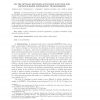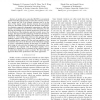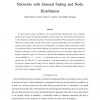9 search results - page 1 / 2 » Distance-based node activation for geographic transmissions ... |
SIAMAM
2011
12 years 7 months ago
2011
In wireless networks, the channels are often subject to random variations that limit the reliability of communications between any two radios. Geographic transmission strategies ca...
TCOM
2010
13 years 2 months ago
2010
In wireless multi-hop packet radio networks (MPRNs) that employ geographic transmissions, sleep schedules or node activation techniques may be used to power off some nodes to cons...
GLOBECOM
2008
IEEE
13 years 10 months ago
2008
IEEE
—In mobile ad hoc networks (MANETs), conventional packet forwarding schemes that pre-select the next-hop receivers for a packet may fail if the channel coherence time is on the o...
CORR
2010
Springer
13 years 4 months ago
2010
Springer
In many wireless systems, interference is the main performance-limiting factor, and is primarily dictated by the locations of concurrent transmitters. In many earlier works, the l...
CORR
2007
Springer
13 years 4 months ago
2007
Springer
—This paper addresses three issues in the field of ad hoc network capacity: the impact of i) channel fading, ii) channel inversion power control, and iii) threshold–based sche...



